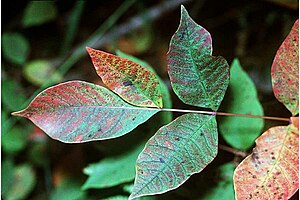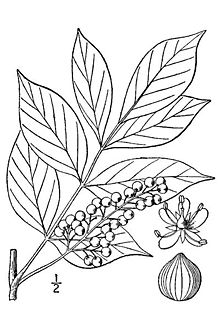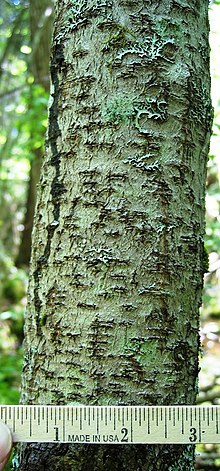Rhus vernix
| Rhus vernix | ||||||||||||
|---|---|---|---|---|---|---|---|---|---|---|---|---|

Leaves of Rhus vernix |
||||||||||||
| Systematics | ||||||||||||
|
||||||||||||
| Scientific name | ||||||||||||
| Rhus vernix | ||||||||||||
| L. |
Rhus vernix L. (Syn .: Toxicodendron vernix ( L. ) Kuntze ) is a species of plant from the genus Rhus within the sumac family(Anacardiaceae). English-language common names are poison sumac and thunderwood, which is used in particular in the south of its distribution area. All parts of the plant contain an oily urushiol , which can cause irritation on the skin and mucous membranes of people. Inhaling the smoke from burnt plants can trigger coughing fits, accompanied by extreme pain and occasional breathing problems.
description

Vegetative characteristics
Toxicodendron vernix grows as a shrub or small tree that reaches heights of up to 9 meters. The bark of the branches is initially light gray and becomes darker with age.
The alternate leaves are arranged in a petiole and a leaf blade. The imparipinnate leaf blade consists of 7 to 13 pinnate leaves . The leaflets are oval to oblong with a length of 2 in (51 mm) to 4 in (102 mm) with an obverse-wedge-shaped base and a pointed upper end as well as a wavy edge. Their underside is hairy bald or sparsely downy. The stems of the leaflets are red and partly framed in red, especially at the top of the plant.
Generative characteristics
The flowers are loosely arranged in lateral, paniculate inflorescences. The greenish flowers are 3 in (76 mm) to 8 in (203 mm) long. The fruits, gray or creamy white when ripe, are about 0.2 in (5 mm) in diameter, not entirely spherical and flattened.
Occurrence
Rhus vernix is common in the eastern United States and in the extreme southeast of Canada . It grows exclusively on moist, loamy soils , usually in swamps and peat bogs .
Toxicity
In terms of the potential to cause urushiol-induced contact eczema , Rhus vernix outperforms its close relatives Rhus radicans and Rhus diversilobum . According to some botanists, Rhus vernix is the most poisonous plant species in the United States.
The differences in the toxicity of the three species result from the different side chains of the chemical substances contained in the plant parts. Normally, Rhus radicans have C 15 chains and Rhus diversilobum C 17 chains, while Rhus vernix has a C 13 chain.
The dermatitis itself manifests itself in painful and long-lasting swellings and rashes. In the worst case, inhaling the smoke from burned plants leads to life-threatening pulmonary edema when the alveoli fill with fluid.
swell
literature
- Aaron Gladman: Toxicodendron Dermatitis: Poison Ivy, Oak, and Sumac . In: Wilderness & Environmental Medicine . 17, No. 2, June 2006, pp. 120-128. doi : 10.1580 / PR31-05.1 .
- Jere Guin, William Gillis, John Beaman: Recognizing the Toxicodendrons (poison ivy, poison oak, and poison sumac) . In: Journal of the American Academy of Dermatology . 4, No. 1, January 1981, pp. 99-114. doi : 10.1016 / S0190-9622 (81) 70014-8 . Retrieved May 1, 2015.
- William L. Epstein: The Poison Ivy Picker of Pennypack Park: The Continuing Saga of Poison Ivy . In: Journal of Investigative Dermatology . 88, No. 3 Suppl., March 1987, pp. 7s-11s. doi : 10.1111 / 1523-1747.ep12468865 .
Individual evidence
- ↑ a b Harriet L. Keeler: Our Native Trees and How to Identify Them . Charles Scribner's Sons, New York 1900, pp. 94-96.
- ↑ Colby Rucker: Tall Trees of Maryland . 2003. Retrieved January 20, 2012.
- ↑ Edward Frankel: Poison Ivy, Poison Oak, Poison Sumac and Their Relatives; Pistachios, mangoes and cashews . The Boxwood Press, Pacific Grove, Calif. 1991, ISBN 0-940168-18-9 .
- ^ Poison Sumac .
Web links
- Toxicodendron radicans / diversilobum / vernix in "The Medicinal Herb FAQ" (English)
- The Poison Sumac Page - Photos and data to vernix Toxicodendron (English)
- Wayne P. Armstrong: Poison Oak: More Than Just Scratching The Surface. In: Wayne's Word. Retrieved July 12, 2020 (English, article about Toxicodendron diversilobum ).
- PDF Toxicodendron vernix


